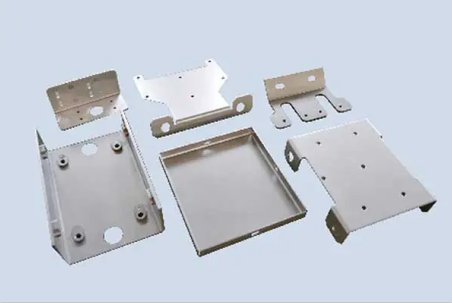The purpose of sheet metal processing surface treatment:
Since some sheet metal materials do not have the ability to prevent rust and corrosion, they need to undergo surface treatment to achieve their goals.
There are two main purposes of surface treatment:
1. Improve the service life of the product in harsh environments, which refers to the ability to prevent rust and corrosion.
2. In order to obtain the desired surface effect or function, it means to meet the appearance requirements of the product.
The surface treatment of sheet metal processing manufacturers is usually electroplating, spraying, anodizing, etc.
1. Spraying: Spraying is divided into spraying paint and powder spraying. After the material is pre-treated, the paint is sprayed on the surface of the precision sheet metal workpiece with a spray gun and gas, and the paint forms a coating on the surface of the workpiece. protective effect;
2. Electroplating: galvanized color zinc, white zinc, blue zinc, black zinc, nickel plating, chrome plating, etc.; it mainly forms a protective layer on the surface of the material for protection and decoration;
3. Other surface treatment methods: anodizing, chromate, wire drawing, sandblasting, oxidation, etc.
Matters needing attention in sheet metal processing surface treatment:
1. All electrochemical treatment should be carried out in the state of the parts, because the chemical solution during the treatment process will be trapped in the crevices of the assembly and cause corrosion;
2. Spot-welded parts can be chemically treated, but not electrochemically treated (including electroplating, anodizing);
3. Aluminum alloy castings cannot be anodized with sulfuric acid;
4. Thin and long tubular parts (the length of which is greater than 2 times the diameter) are generally not suitable for electrochemical treatment, because there will be no film on the inner surface; (special measures can be taken to meet the requirements in special cases)
5. After the parts with deep grooves or fine holes (generally refers to the depth greater than 2 times the diameter or the opening width, but the fine process can be exempted from this limit), the inner surface of the parts will not be completely covered with the coating;
6. It is best to carry out phosphating treatment before spraying the steel parts to increase the adhesion of the coating;
7. In order to improve the corrosion resistance of steel parts plated with bright nickel, copper or dark nickel can be plated first;
8. Zinc-based alloys generally use electroplating as protective decoration. In order to improve the bonding force of the coating, it is generally necessary to pre-plated copper or nickel;
9. Since most organic gases have a corrosive effect on zinc, the galvanized layer should be carefully selected in the design of sheet metal processing to be in contact with organic materials or assembled in the same closed body;
10. For electroplated (oxidized) parts that require riveting, the processing procedure must be electroplating (or oxidation) first, and then riveting.
The above are the relevant surface treatment and precautions for sheet metal processing. Chaohua Metal Sheet Metal Processing has a complete processing technology, including: laser cutting, bending, riveting, welding, grinding and polishing and surface treatment. Provide solutions for sheet metal processing and accessories required.


Get the latest news of JAVA Metal